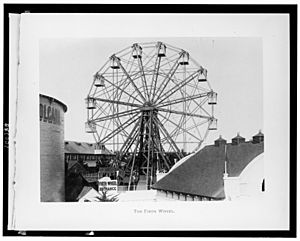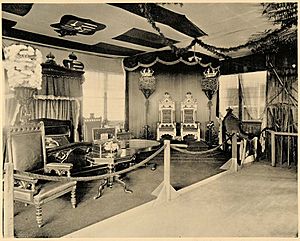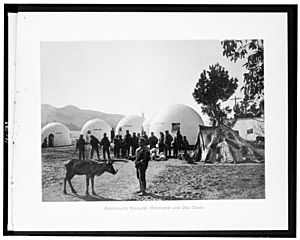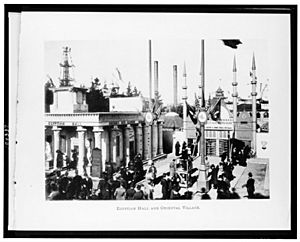California Midwinter International Exposition of 1894 facts for kids
Quick facts for kids 1894 San Francisco |
|
|---|---|

The Main Concourse
|
|
| Overview | |
| BIE-class | Universal exposition |
| Name | California Midwinter International Exposition |
| Area | 200 acres (81 hectares) |
| Visitors | 2.5 million |
| Location | |
| Country | United States |
| City | San Francisco |
| Coordinates | 37°46′14″N 122°28′03″W / 37.77064°N 122.46749°W |
| Timeline | |
| Opening | January 27, 1894 |
| Closure | July 4, 1894 |
The California Midwinter International Exposition of 1894 was a big World's Fair held in San Francisco's Golden Gate Park. It ran from January 27 to July 5, 1894. People often called it the "Midwinter Exposition" or the "Midwinter Fair."
This fair was created to help California's economy during a tough time. It showed off California's great weather, even in winter. It also highlighted the state's many opportunities. Over 2 million people visited the fair. It covered 200 acres and had 120 buildings.
The fair featured four main buildings. These included the Fine Arts Building, the Agriculture and Horticulture Building, the Mechanical Arts Building, and the Manufacturers and Liberal Arts Building. Some parts of the fair, like the famous Japanese Tea Garden, are still in the park today!
Contents
Why the Fair Was Created
In 1893, a man named Michael H. de Young from San Francisco visited the World's Columbian Exposition in Chicago. He saw how much good a world fair could do for a city. He thought California could benefit from hosting its own fair.
De Young imagined a fair in the middle of winter. People from colder places could enjoy California's nice weather. He also wanted to boost California's economy. The state, like the rest of the country, was facing a difficult economic period. De Young and other leaders believed a fair would create jobs. It would also make the local economy stronger. Their bigger goal was to show California as a land of many chances. They wanted to highlight its good weather and rich farmlands.
People quickly supported de Young's idea. He raised over $41,000 in just two weeks. Many businesses from the Chicago fair decided to move their exhibits to San Francisco. The Mayor of San Francisco and the Governor of California also supported the plan. The public helped by donating money. The fair was paid for entirely by donations. It didn't use any government loans or grants. In the end, the fair raised over $344,000 and finished without any debt.
Amazing Buildings at the Fair
The fair had many impressive buildings. They were designed in different styles.
Administration Building
The Administration Building was at the west end of the Grand Court. This is where the Spreckels Temple of Music is now. This building held the offices for the fair's leaders and staff. Its design mixed Arabic, Byzantine, Gothic, and Islamic styles. It had a tall 135-foot dome. The building was lit by natural light during the day. At night, it glowed with electric lamps. You could see it from far away.
Agriculture and Horticulture Building
The Agriculture and Horticulture Building was next to the Fine Arts building. It's now part of where the DeYoung Museum stands. It cost $58,000 to build. The design looked like California Mission style with Romanesque touches. It had three domes to let in light for the plants. Inside, you could see beautiful plants and flowers. There were also California fruits, grains, and even livestock.
Bonet Tower
The Bonet Tower was a huge steel tower in the middle of the fair. It showed off the new discovery of electric lighting. French architect Leopold Bonet designed it. Standing 266 feet tall, it was about a third the size of the Eiffel Tower. The tower was covered with 3,200 colorful lights. A spotlight at the top lit up parts of the park. It also shone on nearby Lone Mountain.
The tower was the fair's biggest money-maker. Rides to the top cost 25 cents. Rides to the first level cost 10 cents. The tower stayed for two years after the fair. Then, park superintendent John McLaren had it taken down.
Fine Arts Building
The Fine Arts Building is now the de Young Museum. It was built to hold all the art for the Midwinter Exposition. The building looked like ancient Egyptian temples. It had images of Hathor, an Egyptian goddess. The building was 50 feet high. Its roof had skylights and iron supports.
After the fair, the Fine Arts Building became a free public museum. Many artists donated their works. The building lasted 11 years. Then, an earthquake in 1906 damaged it. It was closed for repairs. The original building was finally torn down in 1929.
The Fine Arts Building showed art from 68 artists. Twenty-eight of them were women. Many of these women studied at the California School of Design. This school accepted women and hired female teachers. Their colorful paintings of California scenes are important visual memories of the past.
Manufactures and Liberal Arts Building
The Manufactures and Liberal Arts Building was the biggest building at the fair. It was designed in a Moorish style. It cost $113,000 to build. The building had three sections: manufactures, liberal arts, and ethnology/archaeology.
The liberal arts section showed displays from universities like University of California and Yale University. The manufactures section had many items from the Chicago fair. The ethnology/archaeology section showed models, statues, and inventions from many different places. It was also a large store for goods from around the world.
Mechanical Arts Building
The Mechanical Arts Building showed off the latest in engineering. It also housed the machinery that powered the fair's electricity. It was located where the California Academy of Sciences stands today. In the center of the building was a huge gilded globe. It showed the total amount of gold found in California up to that time. In 1894, this globe weighed over 2,000 tons!
Other Important Places
Emergency Hospital
The emergency hospital was located in the heart of Golden Gate Park. It was next to the police station. The hospital building had an unusual cross shape. It also had large red crosses painted on it. It was officially named Lengfeld's Pharmacy. It showed how modern medicine was becoming.
The hospital had doctors and an ambulance. The ambulance was brought from the Chicago World Fair. After the Midwinter Fair, this ambulance was bought by Theresa Fair. She later donated it to San Francisco. This led to the first continuous ambulance service in the United States.
Almost 2,000 people were treated at the hospital during the fair. Injuries ranged from small cuts to more serious ones. Once, a stagecoach overturned, hurting 13 people. The ambulance made many trips to help everyone.
Santa Barbara Amphibia
The Santa Barbara Amphibia was an exhibit that showed marine life from the Santa Barbara channel. It had a huge tank holding 40,000 gallons of seawater. This tank was designed to look like the animals' natural home. It featured sea lions, sea otters, and leopard sharks. There was also a preserved Basking shark on display. The Mayor of Santa Barbara helped create this exhibit. He also sent Mexican leather work, seashells, and mosses. A Spanish band played music for visitors.
Fun Exhibits and Rides
Boone's Wild Animal Show
The Daniel Boone's Wild Animal Show was a very popular attraction. It featured trained and wild animals. The show was known for its lion trainer. Sadly, there was a serious incident during a show. An attendant was attacked by lions when the lights went out. The show was stopped after this event.
Amusement Rides
The Midwinter Fair had several exciting amusement rides.
- Dante's Inferno was a scare exhibit. Visitors entered through the mouth of a golden dragon.
- The Firth Wheel was a giant Ferris wheel. It was like the first one built for the Chicago World Fair. The Firth Wheel was 120 feet tall. It could carry ten people per carriage. A full ride took about twenty minutes.
- The Scenic Railway was an early wooden roller coaster. It had many ups and downs. Riders could see the whole fair while on the ride.
The Haunted Swing
The Haunted Swing was a very popular ride. It made riders feel like the room was spinning all the way around. But actually, the riders stayed still! The room around them spun, creating an amazing illusion.
Mining Camp
The Mining Camp was one of the most unique and popular exhibits. It cost about $2,500 to build. The camp showed what life was like for California miners in 1849. It had a painted backdrop of Mount Shasta. Attractions included a stagecoach that was "held up" daily by bandits. There were also gambling tables, a dance hall, a saloon, and gold-panning areas. A man played the banjo on top of the stagecoach. Workers in the camp would sing along to "The Days of '49."
The Mining Camp also had replica cabins of famous Californians. These included industrialist John W. Mackay and writer Mark Twain. It cost an extra 25 cents to enter the Mining Camp. This was almost half of the fair's 55-cent entry fee. The '49 Dance Hall and Theatre were also part of the exhibit. Each cost an additional 25 cents. The dance hall was very popular, especially with its Spanish dancers.
The Gum Girls
The gum girls were a unique part of the fair. These young women sold chewing gum to visitors. They wore blue dresses, black stockings, and matching caps. Their dresses were considered short for the time because they showed their ankles. The gum girls were known to be friendly and flirtatious to help sell their gum. They had a special song they whistled called "Two Little Girls in Blue." They whistled it every time they made a sale. This song became very popular throughout the park.
The gum girls sometimes faced unwanted attention. They often traveled in pairs to stay safe. In one story, a man grabbed a gum girl's dress. She reacted by punching him in the face and breaking his nose!
Cultural Exhibits
In the late 1800s, cultural exhibits became popular. They showed groups of people from different parts of the world. These exhibits tried to look like their home environments. The people in the exhibits often lived there for the whole fair. The Midwinter Exposition had many such exhibits. These included the Hawaiian village, the Dahomeyan African village, Japanese exhibits, and more.
These exhibits sometimes caused controversy. Some people felt they showed stereotypes. Frederick Douglass criticized the Dahomeyan Village. He said it made African people look like "repulsive savages." People also worried about how the people living in the exhibits were treated.
Dahomeyan Village
The Dahomeyan Village showed Africans from places like French Congo and Benin. There were 67 people in this village. Sadly, four people died during the exhibit.
Marsh's Japanese Village & Tea Garden
Marsh's Japanese Village & Tea Garden is one of the few parts of the fair that still exist today. It is now known as the Japanese Tea Garden in Golden Gate Park. George Turner Marsh, a businessman interested in Japanese culture, created this exhibit. He worked with a Japanese artist named Toshio Aoki.
In 1894, the village had small man-made waterfalls and lakes. It also had the Taiko Bashi (drum bridge). You could see Japanese plants and birds. Japanese women dressed as "Musumee" served tea and sweets. Entry cost 25 cents for adults and 10 cents for children, including tea and treats. Marsh also had workers offer rides in Jinrickshas, a Japanese form of transportation.
Eskimo Village
The Eskimo Village was three acres large. It featured native Inuit people from Labrador, Canada. The villagers lived in huts that looked like igloos and seal-skin tents. Visitors could even ride on a dog-drawn sled around a track.
Oriental Village
The Oriental Village showed Turkish, Greek, Algerian, and Egyptian cultures. The main part was Cairo street, designed like an Egyptian market. It had shops and people acting out daily life. There was even a fortune-teller. Beyond Cairo street, there was a Turkish Theater and Dance hall with performances. Outside, vendors sold goods from Turkey, Greece, and Algeria.
Hawaiian Village
The Hawaiian Village's main attraction was a painted scene of an erupting Mount Kilauea. Performers danced and chanted daily. The exhibit also had grass huts, a Hawaiian Palace, coffee trees, and hula dancers. A display showed the history of the Hawaiian Kamehameha dynasty. There was also an artificial lake where villagers showed canoe maneuvers.
Food at the Fair
The food at the Midwinter Exposition was very diverse. Restaurants were found in the Chinese, Japanese, and Oriental Villages. You could also eat at the Old Heidelberg, near the Firth Wheel, and at the base of Bonet's Tower. Many kiosks and vendors sold food too. The cultural exhibits offered unique and popular meals. It was also common for people to bring their own food and have picnics in the park.
What Remains Today
After the fair ended, Park Superintendent John McLaren was not happy. He had wanted Golden Gate Park to be a natural escape. He felt the fair had ruined its natural beauty. The fair's managers had promised to restore the park, but they didn't.
McLaren had most of the 100 buildings torn down. He even had the concrete foundations dug up. He worried Bonet's Tower would stay forever, so he had it blown up and sold for scrap. However, McLaren did spare some structures. These can still be seen in the park today. The Fine Arts Building (now the De Young Museum) and the Japanese Village (now the Japanese Tea Garden) still exist. Some statues and parts of the Court of Honor also remain.
Mayor Adolph Sutro saved some attractions before McLaren destroyed them. Sutro bought the Camera Obscura, the Firth Wheel, Dante's Inferno, and the Mirror Maze. He moved them to the Sutro Baths, which opened in 1896.
Remaining Sculptures
Many artworks from the Midwinter Fair can still be seen in Golden Gate Park.
- The Apple Cider Press by Thomas Shields Clarke was a working cider fountain during the fair.
- The Doré Vase by French sculptor Gustave Doré is an 11-foot bronze sculpture about winemaking.
- The Roman Gladiator by George Geefs is a bronze sculpture. It is now known as Leonidas, King of Sparta. It was moved to the spot where the fair's construction began.
- The Prayer Book Cross by Ernest Coxhead is a 57-foot sandstone Celtic cross. It was a gift from the Church of England. It marks the first Anglican service in English in California.
-
Doré Vase by Gustave Doré
- The University of California, Berkeley's Bancroft Library has original sheet music from the fair. These include Electric Tower Waltz and Midwinter Fair Polka. They also have a souvenir book with 110 photos by the fair's official photographer, Isaiah W. Taber. More photos can be found in the California Digital Library's collection.
- San Francisco State University's Matthew Evans Resource Room also has many Midwinter Fair photographs. You can find them on its DIVA open digital archive.
Images for kids













